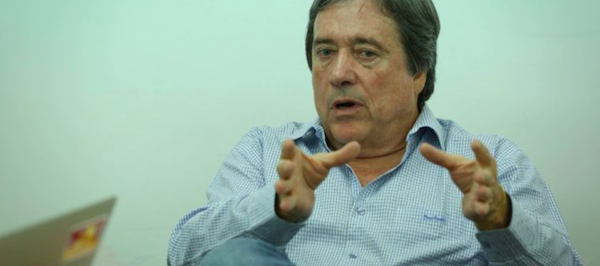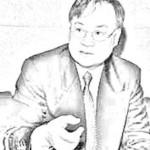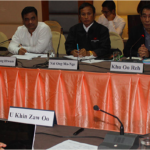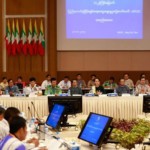By Aung Zaw / The Irrawaddy | December 15, 2016.
Leon de Riedmatten is no stranger to Burma. In 1999, in the heyday of the former military regime, he was head of the International Committee of the Red Cross (ICRC) delegation in Burma, struggling to negotiate with the army generals for access to political detainees at prisons across the country. In 2002, he was the first liaison officer of the International Labor Office (ILO) in Burma.
De Riedmatten facilitated the reconciliation process between the generals and their opposition, including Daw Aung San Suu Kyi. As the country representative for the Swiss-based Center for Humanitarian Dialogue, he pushed forward the talks initiated by Razali Ismail, the UN Special Envoy to Burma in early 2000s. When Daw Aung San Suu Kyi was under house arrest between 2000 and 2002, de Riedmatten was allowed to visit her every fortnight. Until 2004, he was the diplomat who visited her the most.
Since October 2012, de Riedmatten has worked in Burma, acting as an independent adviser to the peace process between the government and the ethnic nationalities. Currently, he is a senior advisor at the Peace Nexus Foundation, which helps communities develop small business projects in post-conflict areas. In this interview with The Irrawaddy’s founding editor-in-chief Aung Zaw, Leon de Riedmatten talks about prospects for genuine peace in the country going forward.
The NLD government and Daw Aung San Suu Kyi have set peace as a top priority. She initiated the much anticipated Burma peace conference. Similarly, in 1947, Gen Aung San, the independence hero, also tried to reach out and sign a ceasefire with some ethnic groups.
But the situation now is much different from 1947. We see in our society that our unity has become very fragmented. And the trust between ethnic groups has been broken down again and again. Leon, you have a lot of institutional memory. What are your thoughts on the peace process now?
I can give you my personal views and obviously it’s my own perception. I represent only myself in this exchange of views.
In 1947, it was more or less the end of the colonization period. And Gen Aung San tried to gather together different autonomous countries and to create a union between these different entities. But, if you look at the reality, at the end of the day, there were only three ethnic states that agreed to be part of the union. And it happened only because Gen Aung San agreed to put in the new Constitution an article that gave the right of secession after 10 years if these other autonomous states were unhappy with the situation.
When we talk about trust, you can see that already at that time, there was very little trust between these ethic nationalities and Burma proper. This is quite important for today because I think it’s great that the new government, like the previous one, puts peace as a priority.
Everyone has to realize that it’s a very complex issue. You cannot solve it in a few days. It will be a very long process. When people talk of building trust, I have some reservations because, as I have said, it was already difficult to gain trust in 1947. How about today, when there has been fighting for decades? Those ethnic states lost their autonomy and were under the control of the central government. In the eyes of ethnic people, the Burma Army occupied their territory, and the central government was favoring the settlement of Burmese nationals in their own states.
It is obvious that reaching peace today will be much more difficult than during the last century, but pragmatism has to prevail because there is no alternative to a peace solution.
The NLD-led government seems to be pushing ahead. But since the Panglong conference, we’ve seen renewed fighting. Even at the Panglong conference, Snr-Gen Min Aung Hlaing, commander-in-chief of the armed forces, spoke about six principles, and he did not mention anything about a federal democratic union, something that Daw Aung Suu Kyi has mentioned.
It may be important to look back and remember what was called tripartite dialogue in the old days. Tripartite dialogue was seen as talks between the Burmese democratic forces as one party, ethnic nationalities as another, and the military as the third.
At this time, I was persona non grata and then blacklisted—between 2006 and 2012—and living in Thailand. The main objective of my discussions with ethnic leaders, members of the democratic opposition, and representatives of civil society was to try to find a consensus on how to approach the military, how to build up a platform that could include democracy and federalism.
This was the past. If you look at the peace process initiated by former President Thein Sein, the aim was to move forward through a dialogue between different stakeholders. It started with bilateral ceasefire agreements between the central state and the ethnic armed groups at the end of 2011 and the beginning of 2012. As an observer, I attended the talks with two of the ethnic groups. I was amazed by how the ethnic leaders were well prepared for the negotiations.
There was a good start with the bilateral ceasefire agreements. Then talks about what became the Nationwide Ceasefire Accord
Unfortunately, before the end of its mandate and prior to the elections, the government tried by any means to have the NCA endorsed and signed by the ethnic armed groups. This was the wrong step. At the last briefing of the MPC [Myanmar Peace Center], the audience was asked for comments about the performance of the center. I took the floor and said it was a mistake to push for the signing of the NCA. The best legacy of Thein Sein’s government would have been to succeed in creating a document that everyone agreed upon. It was the best product to hand over to the next government.
If you look at what’s going on today, there are only eight ethnic armed groups who signed the nationwide ceasefire. And among them, two are very relevant, two others are partially relevant, and a few others are maybe less relevant. So when you talk about nationwide, this representation is not enough on the side of the ethnic armed groups. Another side effect is a split between signatories and non-signatories
My second point is related to the tripartite dialogue. Today, the structure is different than in the old days. One pillar is the central state, another is ethnic armed groups, and the last is political parties. In the central state, the army and the government are together.
Then comes your point, which is very relevant: do the army and the government share the same vision of the future for the country, since they comprise the same pillar? The first thing that has to be observed today is to see if the two partners can find common ground, one that fits with the aspirations of the ethnic nationalities.
I want to circle back to the previous peace deal under former President Thein Sein’s government. It seems like within the five years time, they wanted to achieve a credible process which was backed by the international community, the UN, and neighboring countries. There was a lot of excitement about this.
In the end, I found there were two problems: One is that U Thein Sein’s government didn’t have strong public support. Second, ethnic groups do not trust them. U Thein Sein’s government rushed [the NCA] because he wanted to build his own legacy. But in the end, there was no substance to it.
Let me disagree. Because what I have said before is that the NCA document is there. And everyone at the table—the Kachin, the Chin, and others, had agreed upon the document’s substance. I think it was good grounds for dialogue.
Where I agree with you is that it was certainly a mistake to push for signing the NCA in October 2015, just in order to possibly get more votes in the election. This created the situation today and the split between the groups who signed [the NCA] and those who did not. Furthermore, apparently if you do not sign, you cannot participate in political dialogue. This is the wrong approach. I think it would be better to go back to what was the positive outcome of the peace process under the previous government: the document of the NCA. All stakeholders must have a seat at the table and discuss the framework of political dialogue. The key is that there must be common ground within the central state components.
A lot of observers and supporters thought that among ethnic groups there would be more trust, and that it would be easier to build trust with a government under [Daw Aung San Suu Kyi’s] leadership. But the criticism now is that the government, Daw Aung San Suu Kyi and the army are acting together. Do you agree with that? Do they share the same vision?
I don’t agree with this. But I understand that there is this ambiguity that could be conducive to creating doubts about the real intention of the central state entities involved in the [peace] process. It is positive that there are talks because if you want to end hostilities, you have to sit around the same table and talk about solutions. It will be a long process, and people will have to show their true face at some point.
Pragmatism means that the peace process should not be an exercise that moves parallel to the activities of the government. What is included in the interim arrangements of bilateral and nationwide ceasefire should be part of government policies when it concerns development and investment in post-conflict areas. In addition, I believe in empowering communities. Due to the cessation of hostilities, communities may start to improve their livelihood through small businesses and also keep their identity, their language, their culture, and so on.
This is complementary to dialogue and can make it successful.
So it’s not just about big talk. I think you’re also suggesting that we go on the ground to build.
Yes, a bottom-up approach. If you do this with communities, at a certain point, maybe they will feel comfortable enough to say, “Okay, why are there still people thinking of antagonism, or fighting, and so on, while our situation is acceptable?” You cannot have 100 percent of what you want, but at least you can try to get close.
If this goes at the same time as the talks—and if there is also an understanding at all levels of government that when a company, for instance, is going to move into these specific post-conflict areas that there should be a special approach—these will be practical steps toward building trust. There should be an approach where donors and investors don’t just work with the government, but other stakeholders are included in the preparatory discussions, too. It can mean armed groups, civil society, and communities, and when a kind of overall understanding is reached among [these groups], projects may start. From the ethnic groups side, communities could get some dividends from the cessation of hostilities in certain areas, but at the same time, ethnic armed groups don’t want to see big development projects that may transform the existing landscape in areas of mixed control while a durable peace has not yet been reached.
Going back to the question of livelihood and community development in [ethnic] areas, look at Kachin [State]. The KIO and KIA have good support within their constituency. But some ethnic armed groups don’t have this kind of support. They have their guns, their armies, but they don’t have support within their communities.
This is difficult to judge. I remember a high-ranking Karen civil servant I introduced to one of the KNU leaders. He told him, “I am so pleased to see you because thanks to you, the Karen entity is still alive.” So it’s a notion that’s difficult to measure.
What is also interesting to notice is how things have evolved over all these years. Today, you have heavy fighting in Kachin and northern Shan states. As you said, the KIO and KIA are involved by defending themselves. In the old days, the KIO was the closest group to the military government. The KIO signed a ceasefire in 1994. At the national convention, from 2004 to 2007, it was the KIO that was the leading ethnic group. The Kachin were accused by others of being too close to the military government. At that time, the KNU was the bad guy. And now the situation has completely reversed. So nothing is permanent.
There have been accusations from other groups, Burmese groups, that [the KIO, KIA, KNU] don’t have a unifying position with which to approach the establishment and central administration, whether the government or the military and that the military is ready to exploit these divisions and fractures.
Yes and no. During the years I was outside the country against my will, what I tried the most to do was to find common ground between ethnic armed groups. Even if they could not agree on everything, they could agree on what was essential to build a platform that would allow them to negotiate with the central state later. And I would say that I didn’t see huge differences between the aspirations of the KIO and the KNU, they were more or less the same. They are looking for a federal nation. Maybe there was a certain kind of competition for having a leading role within the ethnic armed groups but what they were looking for was the same.
What is your advice to Daw Aung San Suu Kyi? You have known her since 2000. And you have been involved in private or secret negotiations between the regime led by Sen-Gen Than Shwe and the government led by Daw Aung San Suu Kyi. What is your advice to fix things, to rebuild things, to bring them back?
It was a long time ago I was involved in this, I’d say, “politics.” I’ve met Daw Aung San Suu Kyi only once recently about this, in February 2011. It was the last time we talked about the situation. Since then, we’ve had occasions to meet from time to time, but there was no discussion about the situation. I think I’ve already said more or less what was needed. You cannot talk about nationwide ceasefire if you don’t include everyone. So I believe that it’s time to rethink the approach, and to try again to really have everyone sitting around the same table and having the central state coming with a concrete proposal about federalism. Then, ambiguities will be gone. And then maybe a genuine discussion about the future can really start.
Without ceasefire, without stopping the fighting, how can we sign the nationwide ceasefire agreement on the table?
It’s something I cannot answer for others. But obviously, there should first be a real truce in the field. And then they can sit and talk. Their second request was inclusiveness, meaning that every ethnic armed group participates in the talks. So I think these are genuine demands. These should be agreed upon. I think that it doesn’t contradict what Daw Aung San Suu Kyi has said.
This interview has been edited for clarity and brevity.
This article originally appeared on the Irrawaddy on December 15, 2016.






